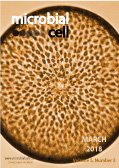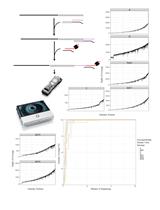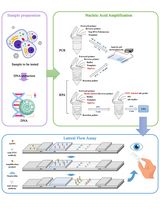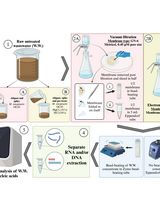- EN - English
- CN - 中文
Viral Double-Stranded RNA Detection by DNase I and Nuclease S1 digestions in Leishmania parasites
在利什曼原虫中利用DNase I和 Nuclease S1酶解进行病毒双链RNA鉴定
发布: 2020年05月05日第10卷第9期 DOI: 10.21769/BioProtoc.3598 浏览次数: 5788
评审: Alexandros AlexandratosAmit DeyOmar Akil
Abstract
Many RNA viruses are found in protozoan parasites. They can be responsible for more serious pathology or treatment failure. For the detection of viral double-stranded RNA (dsRNA), sequence-dependent and -independent methods are available, such as quantitative real-time PCR and immunofluorescence, dot blot, ELISA or sequencing. The technique presented here is sequence-independent and is well detailed in the following protocol, taking the example of Leishmania RNA virus (LRV) in Leishmania guyanensis (Lgy) species. To summarise, the protocol is divided into four major steps: RNA extraction from the parasites, RNA purification, enzymatic digestions with DNase I and Nuclease S1, and visualization by gel electrophoresis. This method can be used to detect other viral dsRNA in other parasites. It provides an additional tool, complementary to other techniques previously cited and it is easy and quite fast to achieve.
Keywords: dsRNA (dsRNA)Background
The wide diversity of RNA viruses present in protozoan parasites has been well documented (Wang and Wang, 1991; Ghosh et al., 2012; Zangger et al., 2014; Lye et al., 2016; Akopyants et al., 2016; Fernandez-Presas et al., 2017; Grybchuk et al., 2018). Moreover, these viruses have been described as potential virulence factors (Fichorova et al., 2013; El-Gayar et al., 2016; Rath et al., 2019). Of particular note, the presence of the endosymbiont Leishmania RNA virus (LRV), a Totiviridae double-stranded RNA (dsRNA) virus, in Leishmania guyanensis (Lgy) exacerbates leishmaniasis disease (Ives et al., 2011; Rossi et al., 2017), favors metastasis by inducing interleukin-17 (Hartley et al., 2016) and also increases the risk of treatment failure (Adaui et al., 2016; Bourreau et al., 2016; Vieira-Gonçalves et al., 2019). This shows the importance of viral dsRNA detection in parasites. The technique presented here is sequence-independent, in comparison to quantitative real-time PCR, so it can be applied widely to RNA viruses. This dsRNA detection protocol can also, and is recommended, to be used to confirm (or be confirmed with) other methods of detection that are sequence-independent or -dependent, as for example dot blot or PCR (Zangger et al., 2013). The technique is presented here with LRV, however its application is possible for other RNA viruses and in other parasites (Grybchuk et al., 2018).
Materials and Reagents
- Eco Nitrile PF 250 Gloves (ecoSHIELDTM)
- Filter tips Low retention 1,000 µl, 200 µl, 20 µl (ClearLine, catalog numbers: 713118 , 713117 , 713115 , respectively)
- 10 µl Extended Length Filter Tip (Neptune Scientific, catalog number: BT10XL )
- Tissue culture flask 25 version “Vent” (TPP®, catalog number: 90025 )
- Vacuum Filtration 500 “rapid”-Filtermax, PES membrane 0.22 μm pore size (TPP®, catalog number: 99500 )
- Microcentrifuge 1.5 ml tubes (Corning, Axygen®, catalog number: MCT-175-C )
- Polypropylene conical 50 ml centrifuge tubes (TPP Techno Plastic Products, catalog number: 91050 )
- 2 ml serological pipettes (FALCON®, catalog number: 357507 )
- 5 ml serological pipettes (SARSTEDT, catalog number: 86.1253.001 )
- 10 ml serological pipettes (SARSTEDT, catalog number: 86.1254.001 )
- 25 ml serological pipettes (SARSTEDT, catalog number: 86.1685.001 )
- Dulbecco's Phosphate-Buffered Saline (DPBS) (Thermo Fisher Scientific, GibcoTM, catalog number: 14040091 ) stored at 4 °C
- Schneider’s Drosophila Medium w: L-Glutamine and 0.40 g/L NaHCO3 (PANTM BIOTECH, catalog number: P04-91500 ) stored at 4 °C
- Fetal Bovine Serum (FBS) (Thermo Fisher Scientific, GibcoTM, catalog number: 10270106 ), sent at -20 °C, then heat-inactivated (see Recipes from Bio-protocol by Reverte and Fasel, 2019), aliquoted to 50 ml tubes and stored at -20 °C
- HEPES Buffer 1 M (BioConcept, catalog number: 5-31F00-H ) stored at 4 °C
- Penicillin-Streptomycin (P/S) solution (10,000 IU/ml P and 10 mg/ml S) (Bioconcept, catalog number: 4-01F00-H ), sent at -20 °C, then stored at 4 °C for short-term storage
- Hemin BioXtra, from Porcine (Sigma-Aldrich, catalog number: 51280 ) stored at 4 °C
- Folic acid (FlukaTM, catalog number: 47620 ) stored at 4 °C
- 6-Biopterin (Sigma-Aldrich, catalog number: B2517 ) stored at -20 °C
- TRI® reagent (Molecular Research Center, MRC, catalog number: TR118 , 500 ml) stored at 4 °C
- Chloroform (Thermo Fisher Scientific, Fisher Chemical, catalog number: C/4960/15 ) stored at room temperature
- Isopropanol (Thermo Fisher Scientific, Fisher Chemical, catalog number: P/7490/17 ) stored at room temperature
- Ethanol absolute (Thermo Fisher Scientific, Fisher Chemical, catalog number: E/0650DF/17 ) stored at room temperature
- UltraPureTM DNase/RNase-free Distilled Water (Thermo Fisher Scientific, InvitrogenTM, catalog number: 10977-035 ), shipped at room temperature, stored at 4 °C before opening, aliquoted to 1.5 ml tubes and stored at -20 °C
- DNase I, RNase-free 10 U/µl with an activity of 0.2 U/µg on calf thymus DNA (Roche, catalog number: 10 776 785 001 ) stored at -20 °C
- Nuclease S1 (#E576) (Promega, catalog number: M5761 ) stored at -20 °C
Note: Pay attention to the fact that the concentration is specific to each tube and is indicated on the tube by the manufacturer. - Buffer S1 (#E578) (Promega, catalog number: M577A ) stored at -20 °C
Note: The old reference was at 7.4x, but now Nuclease S1 Reaction Buffer is provided at 10x. - 1 kb DNA Ladder 500 µg/ml (NEB, catalog number: N3232S ) stored at 4 °C
- 6x Gel Loading Dye (Purple), no SDS (NEB, catalog number: B7025 ) stored at 4 °C; supplied with the 1 kb DNA Ladder
- Standard Agarose–Type LE for routine gel electrophoresis (BioConcept Ltd, Amimed, catalog number: 7-01P02-R ) stored at room temperature
- Tris(hydroxymethyl)aminomethane, Molecular biology (Biosolve, catalog number: 20092391 ) stored at room temperature
- Boric Acid (Crystalline Powder/Electrophoresis grade) (Fisher BioReagents, catalog number: BP168-1 ) stored at room temperature
- EDTA, Ethylenediaminetetraacetic Acid, Disodium Salt Dihydrate (Crystalline Powder/Electrophoresis grade) (Fisher BioReagents, catalog number: BP120-1 ) stored at room temperature
- SDS, Sodium Dodecylsulfate, Solution 20% pure (AppliChem PanReac, ITW Reagents, catalog number: A3942,1000 ) stored at room temperature
- Ultra-pure water, type Ultra ClearTM (BLANC-LABO) stored at room temperature
- RNase AWAYTM (Molecular BioProductsTM, MBP, catalog number: 7003 ) stored at room temperature
- SYBRTM Safe DNA Gel Stain (Thermo Fisher Scientific, Invitrogen, catalog number: S33102 ) stored at 4 °C
- Complete parasite culture medium (see Recipes)
- Ethanol 75% (see Recipes)
- 10x TBE (see Recipes)
- 2 mM EDTA (see Recipes)
- 1x TBE (see Recipes)
- 1x TBE-SDS 2% (see Recipes)
- 1 kb DNA Ladder (50 µg/ml) (see Recipes)
Equipment
- Autoclaved glass bottles (SCHOTT DURAN)
- -80 °C freezer
- FormaTM Steri-CycleTM CO2 Incubator at 26 °C (Thermo Fisher Scientific, catalog number: 371 )
- Pipette controller (INTEGRA, catalog number: 155017 )
- Pipettes 1,000 µl, 200 µl, 20 µl (Gilson®)
- Pipette 10 µl (Discovery Comfort)
- Laminar flow hood parasite culture (SafeFAST Premium)
- Chemical hood
- Centrifuge 5810 R (Eppendorf) at room temperature and set here at 24 °C
- Centrifuge MICRO STAR 17 (VWR) kept in a cold room at 4 °C
- NanoDropTM ND-1000 Spectrophotometer (ThermoFisher Scientific)
- Water bath (JULABO GmbH)
- Balance (NewClassic MF, MS4002SDR, METTLER TOLEDO)
- Ultra ClearTM (BLANC-LABO) system
Note: The Ultra ClearTM (BLANC-LABO) system delivers Ultra-pure DNase/RNase-free water. - Mini-gel migration system “home-made” (see Figure 2)
- Electrophoresis Power Supply (GIBCO BRL, Life Technologies, ST305) and power cables
- Microwave (FAR)
- Blue LED transilluminator (Dark Reader DR-88X, Clare Chemical Research)
- Camera (Computar iAi CVAA5 IR No C510390B RoHS)
- Video Graphic Printer (SONY, UP-895CE)
Procedure
文章信息
版权信息
© 2020 The Authors; exclusive licensee Bio-protocol LLC.
如何引用
Isorce, N. and Fasel, N. (2020). Viral Double-Stranded RNA Detection by DNase I and Nuclease S1 digestions in Leishmania parasites. Bio-protocol 10(9): e3598. DOI: 10.21769/BioProtoc.3598.
分类
微生物学 > 病原体检测 > PCR
微生物学 > 微生物生物化学 > RNA
分子生物学 > RNA > RNA 检测
您对这篇实验方法有问题吗?
在此处发布您的问题,我们将邀请本文作者来回答。同时,我们会将您的问题发布到Bio-protocol Exchange,以便寻求社区成员的帮助。
Share
Bluesky
X
Copy link













